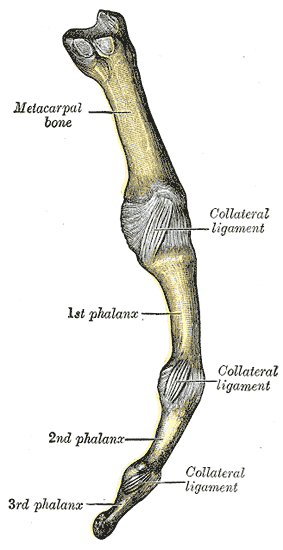Top Qs
Timeline
Chat
Perspective
Collateral ligaments of metacarpophalangeal joints
Ligaments of the hand From Wikipedia, the free encyclopedia
Remove ads
In human anatomy, the radial (RCL) and ulnar (UCL) collateral ligaments of the metacarpophalangeal joints (MCP) of the hand are the primary stabilisers of the MCP joints.[1] A collateral ligament flanks each MCP joint - one on either side. Each attaches proximally at the head of the metacarpal bone, and distally at the base of the phalynx. Each extends obliquely in a palmar direction from its proximal attachment to its distal attachment.[2] The collateral ligaments allow spreading our the fingers with an open hand but not with the hand closed into a fist.
Remove ads
Structure
Each collateral ligament has two parts: a cord-like collateral ligament proper (located more dorsally), and an accessory collateral ligament (located more volarly).[3]
Attachments
The collateral ligaments originate on depressions on each side of the metacarpal heads dorsal to axis of rotation. From there, they extend obliquely and distally to their insertions onto tubercles at the base of the proximal phalanx. The accessory collateral ligaments originate volar to the collateral ligaments and are inserted on the palmar plate.[1]
Remove ads
Function
Due to the relation between their insertions on the sides of the metacarpal head and the axis of rotation in the joint, the collateral ligaments are taut in flexion but lax in extension, while the accessory collateral ligaments are lax in flexion but taut in extension.[1] The collateral ligaments are lengthened 3–4 mm when the joint flexes 0-80° while the accessory collateral ligaments are shortened 1–2 mm. During hyperextension the accessory ligaments are lengthened while the proper ligaments are shortened.[3] As a result, the joint is stable during full flexion while the relaxed collateral ligaments allows lateral and rotation movements during extension.[4]
The tendons of interosseous and lumbricales add to the lateral stability of the joint.[1]
Remove ads
References
Wikiwand - on
Seamless Wikipedia browsing. On steroids.
Remove ads

